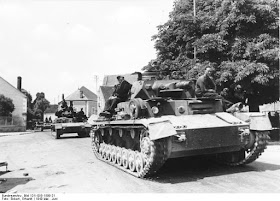Pz-III
The development work was then halted and limited production was begun by Krupp in Magdeburg (Grusonwerk AG), Essen and Bochum in October 1939 with 20 vehicles built. However, even that low number could not be sustained, with production dropping to ten in April 1940. Production also dropped because metal was very expensive and not many citizens were donating it.
Sturm-I
Nevertheless, the number of available Panzer IV's (211) was still larger than that of the Panzer III (98). There were also technical problems with the Panzer III: it was widely considered to be under-gunned with a 37 mm KwK L/45 and production was split among four manufacturers (MAN, Daimler-Benz, Rheinmetall-Borsig, and Krupp) with little regard for each firm's expertise, and the rate of production was initially very low (40 in September 1939, 58 in June 1940) taking until December 1940 to reach 100 examples a month.
SdKf 231 Radio scout car
Pz-I radio wagon
Pz-II
The Panzer force for the early German victories was a mix of the Panzer I (machine-gun only), Panzer II (20mm gun) light tanks, and two models of Czech tanks (the Panzer 38(t) and the Panzer 35(t)).
Skoda T3 DS
Skoda T-15
Pz T-35
Pz T-35
Skoda TNPH
-----Using Blitzkrieg tactics, Guderian, Paul Ludwig Ewald von Kleist and other field commanders such as Rommel broke the hiatus of the Phoney War in a manner almost outside the comprehension of the Allied - and, indeed, the German - High Command. In actual tank-on-tank encounters the German armor performed poorly, but as a coherent unit, the combined arms tactic of the Blitzkrieg shocked the Allies.
------
By May 1940 there were 349 Panzer III's, and 278 panzer IV's are available for the attacks on France and the Low Countries. Through superior command/control and tactics, the Germans were able to prevail in the Battle of France, despite the deficiencies of their Panzers.
That the Panzer III was undergunned was recognized during its conception and its design included a large turret ring to make it possible to fit a 2250 ft/s (656 m/s) 50 mm KwK L/42 gun on later models. In July 1940, too late to see action in the final weeks of the Battle of France, the first 17 of these models were produced. Designated the Panzer III Ausf. F, the other changes included an upgraded Maybach engine and numerous minor changes to ease mass production.
The Ausf. F was quickly supplanted by the Ausf. G, which was the main tank of the Afrika Korps in 1940 - 1941 and also saw action in Yugoslavia and Greece. Around 2,150 Panzer IIIs were produced, of which around 450 were the Ausf G. These tanks were still under-gunned, poorly armored and mechanically overly-complex in comparison to equivalent British tanks.
After fighting in Libya in late 1940 the Ausf. H was put into production with simpler mechanics, wider tracks and improved armor. In April 1941 there was a general 'recall' of the Panzer III to upgrade the main gun to the new 50 mm L/60, with the new Panzergranate 40 round, and muzzle velocity was pushed to 1,180 m/s. New tanks produced with this gun were designated Ausf. J.
As an immediate measure the Panzer III's armor was upgraded to 70 mm by additional plates and spaced armor was introduced to protect against hollow charge attacks. Nonetheless, the Panzer III was clearly outclassed and production was ended in August 1943 with the Ausf. M (a conversion of older types), the vehicle having been up-gunned to a 75 mm L/24 and downgraded to a support role. The Panzer III chassis did continue to be made until the end of the war as the base of a range of special purpose vehicles like Sturmgeschütz III.
Slow production of Panzer IV was continuous, by the end of 1940 386 Ausf. Ds were in use in 1941 and still 480 were produced, although the military order 2200. A short 75 mm gun was the most important advantage of Panzer IV, the weight of armor and was close to the Panzer III. Panzer IV became the most tanks is the Panzer Division, although already outclassed in 1942, it was easy to maintain, and easier to manufacture than other German tanks. Ausf. E was a major production variant, although the Ausf. F2 (later renamed Ausf. G), which has a long high-speed gun was the most impressive performer.
First introduced in 1940, 22-tonne machine was gradually improved with the addition of L / 43 gun most significant change-. It can penetrate 80 mm armor 1800 m Later variants of the further improved gun 75 mm L / 48, but mainly characterized by the addition of the main armor and the addition of spacer and skirt armor to protect against anti-tank weapons. Zimmerit paste, so that the magnetic charges for attaching the Panzer IV.
Approximately 12,000 Panzer IV tanks (derived from the base included) was produced during the war, more than twice as much as the next German tank.
First introduced in 1940, 22-tonne machine was gradually improved with the addition of L / 43 gun most significant change-. It can penetrate 80 mm armor 1800 m Later variants of the further improved gun 75 mm L / 48, but mainly characterized by the addition of the main armor and the addition of spacer and skirt armor to protect against anti-tank weapons. Zimmerit paste, so that the magnetic charges for attaching the Panzer IV.
Approximately 12,000 Panzer IV tanks (derived from the base included) was produced during the war, more than twice as much as the next German tank.























What a collection....Pz-I radio wagon is my favourite...
VastaaPoistaThank you, Phil.
Poista:) It was almost obsessive.
Those Bundeswehr pictures are so good.
Germany's greatness was to first years of the war
and rest are race, against with losses...